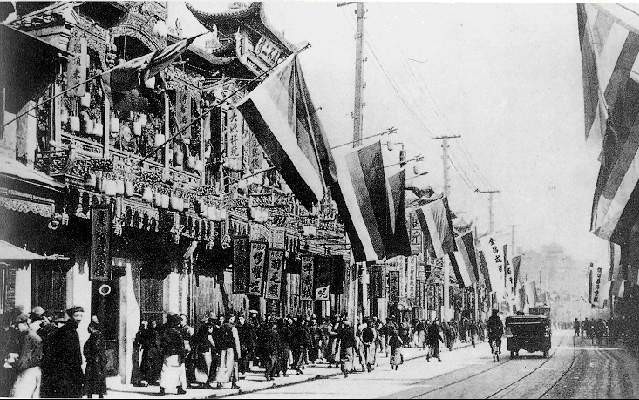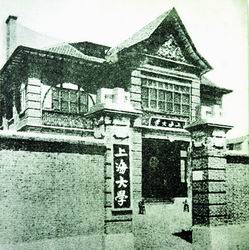|
Line 7, Shanghai Metro
Line 7 is a northwest–southeast line of the Shanghai Metro network. It connects the Baoshan District of Shanghai with the downtown core as well as the Pudong New Area and the Expo 2010 site. It currently runs from in Baoshan District to in Pudong, which is near Shanghai New International Expo Center. serves as a terminus for trains returning to Chentai Road depot. The line is colored on system maps. History * Construction began on November 24, 2005. * The first section of the line from Huamu Road to Shanghai University opened to the public on December 5, 2009. **In the first few months of operation, the trains only operated from 9AM-4PM to allow for extended testing of the line. **On February 20, 2010, operating hours have been extended to fall in line with the rest of the metro system afterwards.http://www.shanghaidaily.com/sp/article/2009/200912/20091203/article_421482.htm *On April 20, 2010, Houtan station entered operation. *In December 2010, three stations on the nor ... [...More Info...] [...Related Items...] OR: [Wikipedia] [Google] [Baidu] |
Zhenping Road Station
Zhenping Road () is the name of an interchange station on the Shanghai Metro. It serves Lines 3, 4 and 7. The station typically handles 108,000 passengers on weekdays. The station is located in Putuo District, Shanghai Putuo District (), is a municipal district of Shanghai Municipality, People's Republic of China. It covers an area of . Putuo District borders Baoshan District to the north, Jing'an District to the east and south east, Changning District to ..., and opened on 26 December 2000 as part of the initial section of Line 3 from to , and Line 4 service began here on the final day of 2005. The interchange with Line 7 opened along with the first section of that line from to on 5 December 2009. Station Layout References Railway stations in Shanghai Shanghai Metro stations in Putuo District Line 3, Shanghai Metro Line 4, Shanghai Metro Line 7, Shanghai Metro Railway stations in China opened in 2000 {{Shanghai-metro-stub ... [...More Info...] [...Related Items...] OR: [Wikipedia] [Google] [Baidu] |
Shanghai New International Expo Center
The Shanghai New International Expo Center is an exhibition center in Pudong, Shanghai. It hosts many exhibitions, including the Shanghai Motor Show. It has also hosted the 2002 Tennis Masters Cup, where one of the halls was temporarily converted into a tennis court. With more than 100 exhibitions per year and a turnover rate of 27 (2015), SNIEC is one of the world's most successful exhibition venues. Construction started on November 4, 1999, with its opening taking place on November 2, 2001. It has, as of 2012, a capacity of 200,000 square meters indoor and 100,000 square meters outdoor exhibition area. Expo Center facilities include 17 exhibition halls, conference rooms, and a business center. Hotel facilities and a subway station are located at one of the entrance halls of the center. Total investment until 2011 was 591 million U.S. dollars. Shanghai New International Expo Center Co., Ltd. is a Sino-German 50:50 joint venture of Shanghai Lujiazui Exhibition Development Co., ... [...More Info...] [...Related Items...] OR: [Wikipedia] [Google] [Baidu] |
Line 2 (Shanghai Metro)
Line 2 is an east–west line in the Shanghai Metro network. With a length of nearly , it is the second longest line in the metro system after line 11. Line 2 runs from in the west to in the east, passing Hongqiao Airport, the Huangpu river, and the Lujiazui Financial District in Pudong. With a daily ridership of almost 1.5 million, it is the Shanghai Metro's busiest metro line. The eastern portion of the line, from to Pudong International Airport, was once operated almost independently from the main segment until April 18, 2019, while through service between these two started the next day. The line is colored on system maps. History The first section of line 2 was opened on October 28, 1999, from to . This section, which included 12 stations, totaled . A year later, was added to the eastern part of the line, adding . Four new stations, located west of the Zhongshan Park station, opened in December 2006, extending the line to . This section added to the line. Four years la ... [...More Info...] [...Related Items...] OR: [Wikipedia] [Google] [Baidu] |
Nanjing Road (Shanghai)
Nanjing Road (; Shanghainese: ''Noecin Lu'') is a road in Shanghai, the eastern part of which is the main shopping district of Shanghai. It is one of the world's busiest shopping streets, along with Fifth Avenue, Oxford Street, Orchard Road, Takeshita Street and the Champs-Élysées. The street is named after the city of Nanjing, capital of Jiangsu province neighbouring Shanghai, and the former national capital of the Republic of China. Today's Nanjing Road comprises two sections, Nanjing Road East and Nanjing Road West. In some contexts, "Nanjing Road" refers only to what was pre-1945 Nanjing Road, today's Nanjing Road East, which is largely pedestrianised. Before the adoption of the pinyin romanisation in the 1950s, its name was rendered as Nanking Road in English. The former Nanking Road lay entirely within the Shanghai International Settlement. Today's Nanjing Road West was formerly Bubbling Well Road, an extra-settlement road built by concession authorities outside the con ... [...More Info...] [...Related Items...] OR: [Wikipedia] [Google] [Baidu] |
Line 4 (Shanghai Metro)
Line 4 is a loop line of the Shanghai Metro network. Its older rolling stock carry a bright purple colour belt to differentiate them from Line 3 trains which share a portion of its route, while the newer stock features a yellow and purple livery, which the exact line is labelled using sticker or screens saying “Line 3” or “Line 4”. To determine the direction of travel, the line that travels counter-clockwise is called the ''Outer Loop'' (), while the other line is known as the ''Inner Loop'' (). Although it is a loop line, trains returning to the depot use as a terminal to let all passengers disembark. The first segment of the line between and (running in a "C"-shape) opened on December 31, 2005. The remainder of the line opened on December 29, 2007. The line is colored on system maps. History October 11, 2009 became China's first national "Worker Pioneer" subway line. Construction accident On August 20, 2001 on 20.10 at construction site during excavating the found ... [...More Info...] [...Related Items...] OR: [Wikipedia] [Google] [Baidu] |
Line 3 (Shanghai Metro)
Line 3 is a north-south line of the Shanghai Metro network. Its older rolling stock carry a bright yellow colour belt to differentiate them from Line 4 trains which share a portion of its route, while the newer stock features a yellow and purple livery, which the exact line is labelled using sticker or screens saying “Line 3” or “Line 4”. Unlike the majority of the lines in the Shanghai Metro system, Line 3 is primarily elevated, entirely above ground except for , located at the entrance to Baosteel Group Corporation. The line runs from in the north to in the southwest of the city, where it meets line 1. While line 1 goes straight through the city center, line 3 roughly follows the Inner Ring Road around the city from to (where it turns eastwards to join the route of the Shanghai–Nanjing railway). The line has about 300 drivers. Between December 26, 2000 and August 8, 2002 the line operated under the name Pearl Line; On August 8, 2002 it was renamed as Rail Transit ... [...More Info...] [...Related Items...] OR: [Wikipedia] [Google] [Baidu] |
Shanghai University
Shanghai University, commonly referred to as SHU, or colloquially Shangda (), is a public research university located in Shanghai. The 555-acre main Baoshan campus is situated in the north of Shanghai, and there are two other campuses in Jiading and Jing'an. It is co-funded by Chinese Ministry of Education and Shanghai Municipal Government as part of the Project 211 and the Double First Class University Plan for leading national universities. Jointly founded by the Nationalists and the Communists in 1922, the original cause for the Shanghai University was to nurture leaders for the Chinese revolution. It contributed a group of influential people to the cause of Chinese liberation and development. The university was discontinued in 1927 as a consequence of the Shanghai Massacre, in which the Nationalists purged all communist-related organizations. In 1983, the Chinese government reopened Shanghai University. And then in 1994, by integrating three other universities, it became ... [...More Info...] [...Related Items...] OR: [Wikipedia] [Google] [Baidu] |
Shanghai Public Transportation Card
The Shanghai Public Transportation Card (SPTC) ( also known as ) is a contactless card, utilizing RFID technology, which can be used to access many forms of public transport and related services in and around Shanghai. Uses The SPTC is a form of rechargeable cash card, and allows access to, among other things in Shanghai: *Metros *Airport maglev *Trams *Buses and trolleybuses *Ferries *Taxis *Tourist centers *Car parks *Fuel stations *Expressways *Auto repair service As of June 2006, the card has been interchangeable with the Wuxi Tai-Lake Transportation Card, and can also be used in Suzhou. Purchase and funding There are five types of SPTCs: *Standard *Memorial *Mini *Personalized *Watch Only the Standard card has a refundable deposit (20 RMB); other cards cannot be refunded, but have a lower deposit (20 RMB) and are resalable through other means. Cards can be reloaded in multiples of 10 RMB, at selected convenience stores, banks throughout Shanghai and service counters ... [...More Info...] [...Related Items...] OR: [Wikipedia] [Google] [Baidu] |
Line 13 (Shanghai Metro)
Line 13 is a north-west to south-east line of the Shanghai Metro network. It runs between in Jiading and in Pudong. It was once used as a dedicated line () for the World Expo to serve the 2010 Shanghai World Expo. The line is colored on system maps. History Special Phase The Special Phase of Line 13 operated between and , during the 2010 Shanghai World Expo. Following the end of the Expo, this phase was closed. 1st Phase The 1st Phase of Line 13 ran between all the stations between and , with 7 stations. The section opened on December 2012. 2nd Phase and 3rd Phase The two phases ran from to in Zhangjiang Hi-Tech Park region. The rest of the line was opened on December 19, 2015. Stations Service routes Important Stations * - located under the busy Nanjing Road. Interchange with lines 2 and 12. * - located near East China Normal University and Global Harbor. Interchange with lines 3 and 4. * - located by Xintiandi Style Mall and the renovated Xintiandi S ... [...More Info...] [...Related Items...] OR: [Wikipedia] [Google] [Baidu] |
Trolleybuses In Shanghai
The Shanghai trolleybus system is a system of trolleybuses forming part of the public transport network in the city of Shanghai, China. Of more than 300 trolleybus systems in operation worldwide (as of 2011), the Shanghai system is the oldest. The system turned 100 years old in November 2014 and was the first trolleybus system anywhere in the world to reach that milestone. For many years, the Shanghai system was also one of the largest in the world, once comprising more than 20 routes and more than 900 vehicles in 1994, accounting for 30% of Shanghai's bus ridership. However the system started to decline in scale and service levels in the late 90s and throughout the 2000s with the fleet shrinking to 150 vehicles in 2012. Those smaller figures still make it one of the largest systems in operation outside the former Soviet Union countries. Since then, the trolleybus network is being expanded with a new expanded fleet of 300 trolleybuses for the 12 surviving lines and the introduc ... [...More Info...] [...Related Items...] OR: [Wikipedia] [Google] [Baidu] |
Island Platform
An island platform (also center platform, centre platform) is a station layout arrangement where a single platform is positioned between two tracks within a railway station, tram stop or transitway interchange. Island platforms are popular on twin-track routes due to pragmatic and cost reasons. They are also useful within larger stations where local and express services for the same direction of travel can be provided from opposite sides of the same platform thereby simplifying transfers between the two tracks. An alternative arrangement is to position side platforms on either side of the tracks. The historical use of island platforms depends greatly upon the location. In the United Kingdom the use of island platforms is relatively common when the railway line is in a cutting or raised on an embankment, as this makes it easier to provide access to the platform without walking across the tracks. Advantages and tradeoffs Island platforms are necessary for any station with many th ... [...More Info...] [...Related Items...] OR: [Wikipedia] [Google] [Baidu] |









